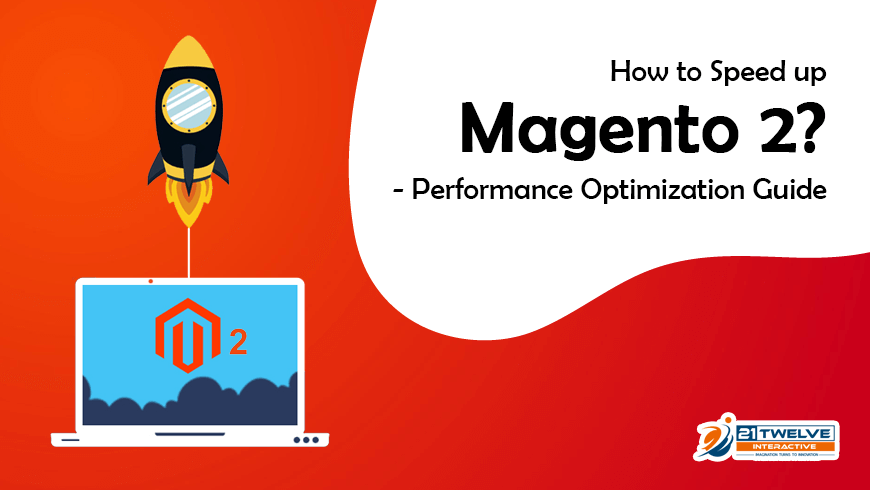
Want to understand how you can speed up your Magento 2 eCommerce Store? Let’s dig into for more info!
Individuals when seeking a virtual shop powerhouse, revert to Magento 2 that is the hero of today’s eCommerce platform market.
It benefits from the limelight because of its sturdiness, flexibility, security, speed, better UX, etc. E-commerce shop owners & developers are completely in awe of it as Magento 2 has better code lines.
However, while engaging in eCommerce Development, many developers feel if they could Speed up Magento 2 for more successful work completion.
Mainly this is due to excessive utilization of manifold customizations. With great speed, keeping customers longer on online stores becomes a piece of cake.
Let us learn about a few more vital tricks of speeding up this fantastic eCommerce platform.
Tips for speeding up Magento 2:
Tip 1: Hosting
To speed up Magento 2, choosing the correct hosting plan is vital. It poses a huge impact on the website’s entire performance.
Using a cheap VPS is not recommended. Commencing render times & receiving good TTFB is possible with fast hosting. Lexiconn & Nexcess are some hostings optimized by Magento.
Tip 2: Deactivate the shipping methods that are not used
Magento is equipped with shipping carriers like USPS & FEDEX and these are activated by default. Even when these are not in use, external gateways will receive requests from them and this slows down checkout procedures.
Hence, deactivate all the shipping methods that are not in use currently and save yourself the horror of a slow website.
Tip 3: Auditing Magento code
The main challenges are template files & PHP code whenever developers need to reduce server response times.
Code profiling can help with Magento’s performance after which discovering the areas that are making the website slow is important. There is a built-in profiler in Magento as well. Third-party extensions can also be utilized in such cases.
Performance management tools can also help increase the speed of Magento websites.
Magento speed optimization largely depends on the fulfillment of its technology requirements.
A solid-state disk & 2G of RAM are two such requisites that on the meeting will bestow developers with decent speed. Choose the hosting plan wisely.
Tip 4: Turning on the production Mode
Before thinking of ways to speed up Magento, developers must know that there are 3 operation modes namely default, production & developer.
Production mode is the fastest one. Utilization of developers & default modes carried out for all debugging purposes. Using for a live website not recommended.
The hosting provider will offer the details for SSH access that will help developers discover the mode they are running in.
Tip 5: Magento server Configuration
Server configuration optimization works as a site speed optimizer that includes picking the correct hosting. Positioning the correct server software is also important.
Meeting these hardware requirements is mandatory:
- Securing manifold affordable resources is recommended
- Selecting a cheap option is not a choice as it is the very foundation of your online shop
- When reverting to Magento 2, more RAM & CPU must be there.
Tip 6: Server misconfigurations
Magento speed largely slows down due to usual server misconfigurations.
Shortage of RAM – The system places swap or data on disk on running out of RAM, thus makes things very slow
Query cache – Query cache is there in contemporary MySQL servers that are disenabled by default. The trick is to enable it for maximum Speed up Magento 2.
Tip 7: Code performance domination
Magento profiler can largely help in optimizing TTFB.
- Slow MySQL query (s)
- Observers running on all page requests
- Template files that are poorly written
Tip 8: Shrinking page size with GZIP compression
A browser will automatically have lesser kilobytes for downloading on compressing the HTML page.
On the side of the server, one has to activate the GZIP compression.
Tip 9: Inspection of 3rd party extension
Formulated by programming experts, Magento 2 core code has not much space for enhancements. But while using extensions, these can slow down a website.
Carrying out 3rd party extensions audit is important if you want to reduce server response times. Speed of the website can also change on turning all modules on & off and clearing caches.
Developers must test page types, category pages & then checkout. When a website speeds upon turning off the extension, there is a presence of an abuser.
The plugin’s vendor must be informed about this performance problem. SSH access is important for putting off the extension. Installing a bug-free Magento 2 speed extension can be helpful.
Tip 10: Enabling cache
The easiest solution to how to speed up Magento 2 website is by turning on a cache.
Just go to the backend menu system and then Cache management & double-checking the settings are important.
Tip 11: Saying no to JS Bundling
It is that characteristic of Magento 2 that cuts down all HTTP requests. These HTTP requests load pages by clustering JavaScript files.
Their performance is good is actually a myth. JS Bundling fabricates a massive 5 to 10 Mb file along with JavaScript code. If looking for Magento performance optimization, you must know that such big files will have a negative effect on page loading time.
You can check whether JS Bundling is put off or not by reaching out to backend menu stores – Configuration – Advanced – Developer.
Tip 12: Utilizing Skip Varnish & Built-in Cache
There are 2 options in Magento 2 for full page cache that are varnish & built-in app. The former needs extra software installation and server management.
Choose anyone at Stores – Configuration – Advanced – System.
However, developers must avoid Varnish as it is 3rd party software & will require upgrades. Also, website visitors can access non-cached random pages.
Tip 13: Enabling flat products & categories
Database loading ability is something that determines the Magento speed test. Speeding up more is possible with Flat Catalog enabling.
Flat Catalog also enables database offloading on getting the request for product showing. This also reduces the complexity of MySQL.
This can be done by clicking on the backend, stores – configuration – catalog – storefront. After that, in the field of Use Flat Catalog Category, simply choose yes.
Tip 14: Checkout
Whenever the payment & checkout process becomes time-consuming, customers might quickly discard their decision of buying from the eCommerce store. Optimizing the checkout page is very important.
With Magento 2 speed up checkout extensions, the checkout page turns into a single page only. This module can offer online stores amazing benefits in the context of sale management.
Tip 15: Combining JS Files and CSS
When thinking of How to speed up Magento, this is an important step. Speed up Magento 2 as you minify and merge the JavaScript and CSS files.
This makes the web pages very light that results in fast loading. Magento 2 must be put in production mode.
CSS File
Backend stored – configuration – advanced – developer – CSS settings
Setting merge CSS files to Yes
Setting minify CSS files to Yes
JavaScript File
Backend, stored – configuration – advanced – developer – JavaScript settings
Setting merge JavaScript files to Yes
Setting minify JavaScript files to Yes
After completion, flushing cache & saving configuration are the next steps for enabling the changes.
Tip 16: Image Optimization
Magento 2 Performance Optimization is possible even more clearly with Image optimization. Page overloading often happens when the size of the image is heavy.
So if you really want to Speed up Magento 2, image compression is vital prior to the submission of any image. For logo & layout, SVG or PNG can be used and JPEG format for all product images.
Tip 17: Content Delivery Network or CDN
Linking every cache server is possible with CDN. The system supports geographical proximity and will also speed up the web page loading time. To set up the Content Delivery Network, go to
Backend, stores – configuration – general – web – base URLs (Secure)
Tip 18: Switching to PHP 7
To determine Magento speed, reverting to PHP 7 is important as it enhances performances and is supported by Magento 2.3.3.
Tip 19: Updating Magento 2
When you are unable to Speed up Magento 2, you must check whether the eCommerce platform is updated or not.
After logging in to the Admin Panel, the dashboard will show you the existing Magento 2 version. Updates are visible in the upper right corner in the form of notifications. Apply the necessary updates are available.
Measuring the speed of Magento
On loading web pages, a browser engages in various actions:
- Obtains HTML data from a server
- Carries out the function of loading external files after analyzing data (CSS/fonts/images)
- It constructs Document Object Map or DOM
- It then places elements on the page
How rapidly a web page can load can be measured with these three time periods:
- Server response time or Time to the first byte – this includes the time when any user clicked on some link till the primary bit of data arrived right from a server
- Start to render – this is about the first time that something was showcased on the screen. Before this, users were viewing blank pages
- DOM complete – this is the time when a browser thinks the page to be loaded. Content loading is done except for the content provoked by javascript execution.
- Fully loaded – Here loading of a web page is done and there is zero performance of any network activity by web browsers
Why Magento page speed is so important?
Running an eCommerce store makes it vital for store owners to know how they can benefit more as they Speed up Magento 2.
- Add to cart servers can receive response times up to 61% faster
- Web page optimization is possible for quicker delivery
- End-to-end checkout times are faster by 48%
- Immediate response time can be achieved in server for catalog browsing
- Enhances efficiency for all backend operations
- More order processing is possible and it increases by 35% per hour
- Handling peak loads becomes a piece of cake with improved database scalability and flexibility
Conclusion
There are manifold performance optimization characteristics in Magento 2. Configuring those features properly is important. Take assistance from a Magento Development Company for getting hold of the best eCommerce stores.
Contact them today if you conveniently wish to cut down on performance time. Utilizing extensions will help you avoid the problems of Magento 2 very slow that can largely affect your brand’s online presence as well.




